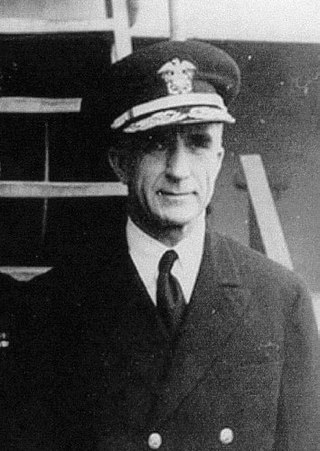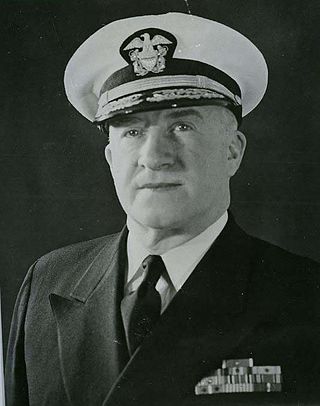The Bureau of Aeronautics (BuAer) was the U.S. Navy's material-support organization for naval aviation from 1921 to 1959. The bureau had "cognizance" (i.e., responsibility) for the design, procurement, and support of naval aircraft and related systems. Aerial weapons, however, were under the cognizance of the Navy's Bureau of Ordnance (BuOrd).

Vice Admiral Morton Lyndholm Deyo was an officer in the United States Navy, who was a naval gunfire support task force commander of World War II.

William Hannum Grubb Bullard was an admiral of the United States Navy, whose service included duty during the Spanish–American War and World War I. After World War I, he established the Navy's patrol on China's Yangtze River. A noted electrical engineer, he wrote a popular handbook on naval electrical systems, and contributed to the use of radio in the Navy.

Lillian Elaine Fishburne was the first African-American female to hold the rank of Rear Admiral (RDML) in the United States Navy. She was appointed to the rank of Rear Admiral by President of the United States Bill Clinton and was officially promoted on February 1, 1998. Fishburne retired from the Navy in February 2001.
Vice Admiral Ferdinand Louis Reichmuth was an officer of the United States Navy who served in World War I and World War II.

The Commander-in-Chief, Plymouth, was a senior commander of the Royal Navy for hundreds of years. Plymouth Command was a name given to the units, establishments, and staff operating under the admiral's command. Between 1845 and 1896, this office was renamed Commander-in-Chief, Devonport. The Commanders-in-Chief were based in what is now Hamoaze House, Devonport, Plymouth, from 1809 to 1934 and then at Admiralty House, Mount Wise, Devonport, from 1934 until 1996.

John "Jack" Roland Redman was an admiral in the United States Navy. A naval communications officer, he played key roles in signals intelligence during World War II in Washington, D.C., and on the staff of Admiral Chester W. Nimitz. He also competed at the 1920 Summer Olympics.

Joseph Reasor Redman was an admiral in the United States Navy. A naval communications officer, he played key roles in signals intelligence during World War II, while he served as Director of Naval Communications.

The Director of Naval Intelligence (DNI) serves as the head of Naval intelligence on the staff of the Chief of Naval Operations. The Director of Naval Intelligence also serves as Deputy Chief of Naval Operations for Information Warfare (N2/N6) on the staff of the Chief of Naval Operations. The Director of Naval Intelligence is not to be confused with the Office of Naval Intelligence, a Navy Echelon III command that serves as the U.S. Navy's Service Intelligence Center and supports the Office of the Chief of Naval Operations and the Director of Naval Intelligence via the Information Warfare Community.

Earl Everett Stone was a rear admiral in the United States Navy. He is most noted for being the first director of the Armed Forces Security Agency, the predecessor to the National Security Agency.

RDML Gretchen S. Herbert is a retired United States Navy officer who commanded the Navy Cyber Forces.

The Assistant Chief of the Naval Staff (A.C.N.S.) is a senior appointment in the Royal Navy usually a two-star rank and has a NATO ranking code of OF-7.

The Operations Division was a former directorate of the Admiralty Naval Staff responsible for the creation and implementation of long-term policy in regards to the composition of all Royal Navy fleets, squadrons and commands and including operational planning and monitoring from 1912 to 1961.

The Admiral-superintendent, Portsmouth was the Royal Navy officer in command of the Naval Dockyard. Portsmouth from 1832 to 1971; prior to this date a resident Commissioner of the Navy Board had had oversight of the yard, since 1649. In May 1971 command responsibility for naval staff in the dockyard was merged into the wider local command structure, initially under the dual designation of Flag Officer, Portsmouth and Admiral Superintendent, Portsmouth but in July 1971 was again renamed Flag Officer Spithead and Port Admiral Portsmouth after a couple of months. These joint titles was used until 1975, and despite the name change the command still covered the same geographic area and operational responsibilities until 1996 when its ceased to exist as a separate command appointment and its responsibilities were assumed by the staff of Flag Officer First Flotilla.

Bernard Franklin Roeder was a decorated officer in the United States Navy with the rank of vice admiral, who held many important assignments, including commander in chief of United States First Fleet and Director of Naval Communications. He also served as first director of the Naval Security Group.

Laurence Allen Abercrombie was a decorated commander during World War II who reached the rank of Rear Admiral in the United States Navy. Admiral Abercrombie was thrice awarded the Navy Cross, the United States military's second-highest decoration awarded for valor in combat.
Danelle Barrett is a retired U.S. Navy Rear Admiral. She is one of less than 200 women in history to achieve the US Naval rank of admiral.











